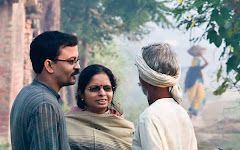VARANASI : "It's a great moment for us that Kailash Satyarthi has been honoured with Nobel Peace Prize," said Lenin Raghuvanshi, one of the founder members of Bachpan Bachao Andolan that came into existence in 1993. Lenin remained associated with BBA till 1999, and later formed People's Vigilance Committee on Human Rights ( PVCHR). "We are still associated with Satyarthi and support him in his work," said Lenin, who had taken part in Global March against Child Labour in 1998 along with the Nobel winner Satyarthi.
The carpet belt of Mirzapur-Bhadohi in eastern UP was his karmabhoomi in the early part of his crusade against child labour and trafficking. Satyarthi worked tirelessly in the carpet belt of Bhadohi and Mirzapur, notorious for exploiting child workers. It was his initiative to start the Rugmark, a label given to carpet makers for guaranteeing that the product is child labour free.
"I met him just 10 days ago at a programme in New Delhi," said Lenin Raghuvanshi. Describing him (Satyarthi) as a true friend of children, Lenin said that they had worked together in rescue operation of child labourers at various places. "I can't forget a rescue operation in Handia, where we faced gun fire," he said, adding that despite the firing, Satyarthi remained firm and successfully rescued 23 children. He himself led most of the rescue operations.
"On December 10, 1996 he led a 'Shoshanmedh Yajna' at Dashashwamedh Ghat after rescuing children from Jansa area," said Lenin. "I sat on 71-hour-dharna at the district headquarters in December 1997 for rescue and rehabilitation of child labourers. It was Satyarthi, who ended my fast," he said.
Shruti Nagvanshi, another former member of the BBA, said that it was the commitment of Satyarthi to a great cause that brought Nobel Peace Prize to him. Shruti was in the state committee of BBA and general secretary at Varanasi.
Satyarthi's another associate Rajiv Kumar Singh of Dr. Shambhunath Singh Research Foundation also recalled the moments he spent with him. "We were together at many times in raids for the rescue of children. We had to face stiff resistance from the employers during rescue operations," he said. "He was even branded as a foreign agent to destroy the carpet industry. But, today the honour of Nobel Peace Prize ended all the negative things and established the truth. We are proud of him," he said.
In 1980, Satyarthi and other leaders of the Bonded Labor Liberation Front in New Delhi launched a crusade against bonded labor and child servitude in the carpet industry. The eastern UP in a triangle from Varanasi to Mirzapur and Bhadohi, was the center of the carpet belt, where it was estimated that about 3 lakh underage children were at work, mostly under inhuman conditions.
Despite the denials of government and industry about bonded child labor in the carpet belt, Satyarthi's crusade, aided by the the Supreme Court, caused the liberation of thousands of children who were discovered in raids by these activists. The activity also generated media attention in Europe, where conditions in the carpet industry of India and Nepal were exposed time and again.
In UP, Satyarthi set up local offices in Mirzapur, Bhadohi, and Varanasi, upgrading their activities and staff. The Varanasi office coordinated activities for a large number of NGOs related to his BBA and South Asian Coalition on Child Servitude (SACCS) throughout the carpet belt, including Mirzapur, Sondbhadra, Bhadohi, Allahabad, Garhwal, Nagaruttarum, Ghazipur, Robertsganj, Palamau, Saharsa, Khagaria and Madhubabni. These pressures have been partially responsible for state officials taking up the issue of bonded child labor. The district administration of Mirzapur, Varanasi, Bhadohi and Ghazipur ordered surveys of children engaged at carpet looms.



No comments:
Post a Comment